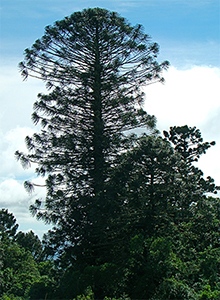Araucaria bidwillii

Other common names
Indigenous: Bunya-bunya, Banza-tunza, Banua-tunya, Boonya, Bunyi, Bahnua, Bunya, and Bonyi-bonyi.
Origin of the species name
Araucaria is derived from the tribe name Aracanos; bidwillii is named after John Carne Bidwill, who brought a live specimen back to England in the mid 1800s.
Family
Araucariaceae
Date planted
September 2009
Lifespan
Trees of this species can live for 600 years.

General description
This is a large evergreen conifer, which in the mature tree has a dome-shaped crown defined by dense tufts of branchlets with the foliage at the branch ends. The dark green glossy leaves taper at both ends and the cones are very large being 20-35cm in diameter and weighing up to 10kg. Height 35m Spread 15m.
Natural distribution and habitat
The species is native to two small populations in south eastern Queensland, Australia. It grows about 160 km from the coast, occupying various habitats from moist valley floors at low altitudes to ridge tops and upper slopes, and is normally found as an emergent over tropical rainforest
Conservation status
Not considered threatened. However, its active conservation in the wild is important now to protect the sacred values which the indigenous people have for the species, as well as to protect it from potential threats from climate change which are anticipated to negatively affect bunya pines in their native range.
Uses
It has been a sacred tree for indigenous Australians for a long time and an important source of food, timber and fibre.
Indigenous Australians eat the nut of the bunya tree both raw and cooked. Traditionally, the nuts were ground and made into a paste, which was eaten directly or cooked in hot coals to make bread. Indigenous Australians also ate bunya shoots, and utilised the trees' bark as kindling.
Groves of Bunya trees were often under particular tribal ownership and as the fruit ripened, indigenous people who were bound by custodial obligations and rights, sent out messengers to invite people from hundreds of kilometres to meet at specific sites in the Bon-yi Mountains (Bunya Mountains) to feast on the kernels.
Many different tribal groups – up to thousands of people – would travel great distances from as far as Charleville, Dubbo, Bundaberg and Grafton to the gatherings. They stayed for months, to celebrate and feast on the bunya nut.
The bunya gatherings involved ceremonies; discussions and negotiations over law, marriage and regional issues; dispute settlements and the trading of goods.
Over time, most of the Bunya forests were felled for timber and cleared to make way for cultivation by non-indigenous settlers.
Indigenous groups such as the Wakka Wakka, Githabul, Kabi Kabi, Jarowair, Gooreng Gooreng, Butchella, Quandamooka, Barrangum, Yiman and Willi Willi traditional owners continue their cultural and spiritual connections to the Bunya Mountains to this day.
A number of strategies including the use of traditional ecological knowledge have been incorporated into the current management practices of the national park and conservation reserves with the Bunya Murri Ranger project currently operating in the Bunya Mountains.
Other uses
Since the mid-1990s, the Australian company Maton has used bunya for the soundboards of its BG808CL Performer acoustic guitars. The Cole Clark company, also Australian, uses bunya for the majority of its acoustic guitar soundboards. The timber is valued by cabinet makers and woodworkers, and has been used for carpentry and furniture for over a century.
Further reading
Farjon, A (2010) A Handbook of the World's Conifers. Brill.
